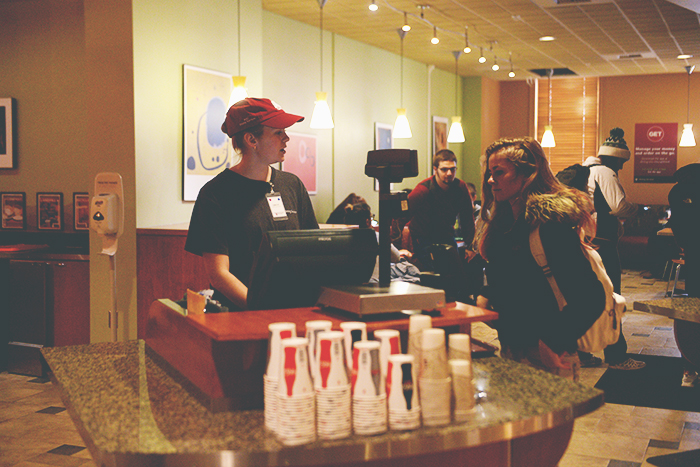RDA is the most responsible form of meal plan
JEMMA GONZALEZ | The Daily Evergreen
Hillside cashier Emily serves customers, most of whom have RDA accounts through WSU Housing and Dining Services.
February 1, 2017
A 19-year-old sophomore and computer science major, Ryan Manny has created a free computer program to measure the different amounts students pay between RDA and Cougar Cash.
It is designed so that students can calculate how much money they lose on an item when they purchase it with RDA. Students enter the price of their item bought from a WSU dining hall or market, the program applies the discount offered by dining halls, which is 40 percent and 10 percent for markets. Then the program calculates how much is really paid when factoring in the base cost of every RDA plan ($944).
Manny said the final cost of an item is usually double the price one would pay using Cougar Cash or a debit card. Though he did not include any sales tax features, using RDA would still cost more.
“Anyone’s qualified to make this statement,” Manny said, “it’s just basic math.”
The Daily Evergreen verified Manny’s program with WSU computer science professor Aaron Crandall.
Crandall checked Manny’s equations and worked through the math himself, examining the program’s coding.
“His numbers seem accurate, his input seems accurate,” Crandall said. “His math seems consistent and correct.”
Crandall further calculated that one RDA dollar in plan one is essentially equivalent to $2.06 in real dollars, $1.81 in plan two and $1.68 in plan three. So a student who purchased plan one is essentially paying $2.00 for $1.00 of RDA.
With the high base cost, Manny said that a student would have to spend about $3,000 to make an RDA plan worth it. He doesn’t believe there’s a reason for anyone who isn’t required to buy RDA to do so. Freshmen are required by WSU to buy an RDA plan and required to live on campus by the WAC code. The base cost has been frozen at $944 since the 2010-2011 school year.
Either way, with the base cost as it is, a student still cannot break even without customizing their plan by adding and spending more money.
Director of Dining Services Gary Coyle said that the money from the base cost goes toward mortgage payments, maintenance, repairs, utilities and some labor. The $30 million cost of refurbishing the dining halls in past years is still being paid off as well, and Housing and Dining is a self-sustaining service — they aren’t looking to make a profit.
Sarah Larson, the associate director of Dining Services, added that students get value in convenience. Dining halls are open until 8 p.m. and are kept at a certain quality. With more money, there are more dining options. She also said that spending money mostly at the dining halls, aside from customizing your plan by adding more money, is the best way to get the most out of an RDA plan, as dining halls offer the largest discount.
Manny said if Housing and Dining don’t lower their base cost, he plans to create a mobile app for his calculator. Currently, his program only works on Windows.
This story has been updated from it’s original version.










